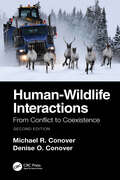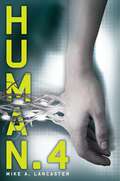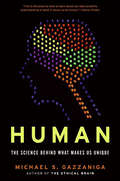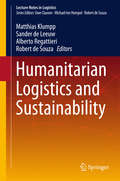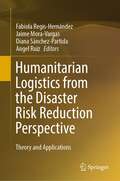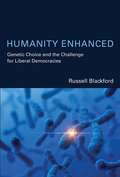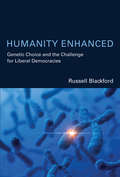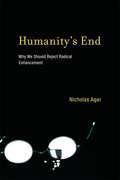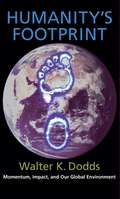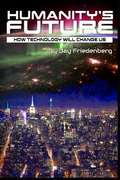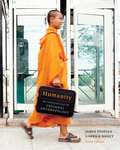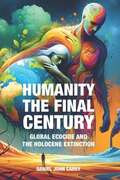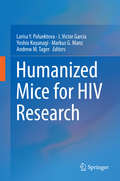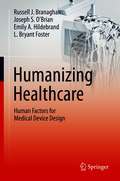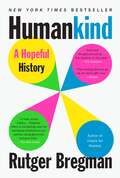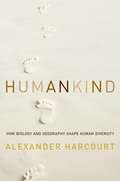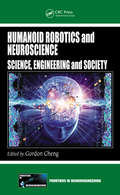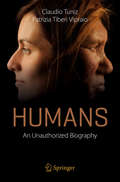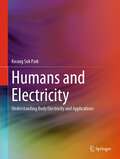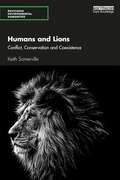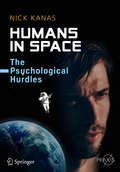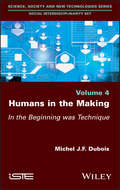- Table View
- List View
Human-Wildlife Interactions: From Conflict to Coexistence
by Michael R. Conover Denise O. ConoverThis book won the 2023 The Wildlife Society Publication Award in the authored book category. Human-wildlife interactions increase exponentially as more and more humans and wildlife crowd into the same limited space. Such interactions often become conflicts when wildlife threaten human health and safety, well-being, or the food supply. This second edition of Human-Wildlife Interactions: From Conflict to Coexistence provides a comprehensive review of the severity of these problems and the methods used to resolve clashes between humans and wildlife. During his forty-year career as a wildlife professor and scientist, Dr. Michael Conover, founder of journal Human-Wildlife Interactions, has become a recognized leader of the scientific field of human-wildlife interactions. In this book, he presents the range of methods for wildlife damage management, including employing lethal methods; distributing supplemental food; changing the behavior of either humans or wildlife; and excluding or repelling wildlife. Backed by numerous case studies and informative side bars, the book documents resolutions to specific human-wildlife conflicts throughout the literature. Containing full color illustrations throughout, the second edition of Human-Wildlife Interactions: From Conflict to Coexistence provides authoritative coverage and depth of both theoretical and practical information. It serves as an invaluable resource for students, researchers, and professional wildlife managers. Disclaimer: Figure 7.7 (b) on page 251 was incorrectly attributed in previous printings. The photographer of figure 7.7 (b) is Cynthia Herrick.
Human.4
by Mike A. LancasterKyle Straker volunteered to be hypnotized at the annual community talent show, expecting the same old lame amateur acts. But when he wakes up, his world will never be the same. Televisions and computers no longer work, but a strange language streams across their screens. Everyone's behaving oddly. It's as if Kyle doesn't exit. Is this nightmare a result of the hypnosis? Will Kyle wake up with a snap of fingers to roars of laughter? Or is this something much more sinister? Narrated on a set of found cassette tapes at an unspecified point in the future, Human.4 is an absolutely chilling look at technology gone too far.
Human: The Science Behind What Makes Your Brain Unique
by Michael S. Gazzaniga“[A] shimmering new book . . . This is the place to look to learn about our best scientific understanding of what it means to be human.” —Steven Pinker, New York Times bestselling author of The Language Instinct and How the Mind Works“A cognitive neuroscientist at the University of California, Santa Barbara (and one of the inventors of the field), takes us on a lively tour through the latest research on brain evolution.” —The New York Times Book ReviewWhat happened along the evolutionary trail that made humans so unique? In his accessible style, Michael Gazzaniga pinpoints the change that made us thinking, sentient humans different from our predecessors. He explores what makes human brains special, the importance of language and art in defining the human condition, the nature of human consciousness, and even artificial intelligence.“As wide-ranging as it is deep, and as entertaining as it is informative . . . will please a diverse array of readers.” —Publishers Weekly, starred review “A rich testimony to the incredible accomplishments of the human brain in coming to understand itself.” —New York Sun“Truly engaging.” —CNBC.com“A savvy, witty guide to neuroscience today.” —Kirkus Reviews“Brilliantly written and utterly fascinating.” —Robert Bazell, Chief Science Correspondent, NBC News“Sweeping, erudite and humorous . . . If you are looking for one book that gives you a Cook’s Tour of the human brain, where it came from and where it is heading, this would be an excellent choice.” —Pittsburgh Post-Gazette
Humanitarian Logistics and Sustainability
by Matthias Klumpp Sander Leeuw Alberto Regattieri Robert SouzaThis contributed volume combines conceptual and strategic research articles dealing with the "why" and "to what end" of sustainable operations in humanitarian logistics, as well as operational research contributions regarding the "how" from the United Nations as well as from researchers and organizations from different countries (Germany, Australia, Singapore, Netherlands, Italy, Denmark, Jordan). The target audience primarily comprises research experts, decision makers and practitioners in the field, but the book may also be beneficial for graduate students.
Humanitarian Logistics from the Disaster Risk Reduction Perspective: Theory and Applications
by Angel Ruiz Diana Sánchez-Partida Fabiola Regis-Hernández Jaime Mora-VargasThis book aims to clarify the priorities of the Sendai Framework for the DRR 2015 – 2030, through gathering recent contributions addressing the different ways researchers define, measure, reduce, and manage risk in the challenge of the DRR. Beyond a discussion of the different definitions of disaster risk; this book provides contributions focused on optimization approaches that support the decision-making process in the challenge of managing DRR problems considering emerging disaster risks in the medium and long term, as well as national and local applications. Some of the topics covered include network flow problems, stochastic optimization, discrete optimization, multi-objective programming, approximation techniques, and heuristic approaches.The target audience of the book includes professionals who work in Linear Programming, Logistics, Optimization (Mathematical, Robust, Stochastic), Management Science, Mathematical Programming, Networks, Scheduling, Simulation, Supply Chain Management, Sustainability, and similar areas. It can be useful for researchers, academics, graduate students, and anyone else doing research in the field
Humanities and Sustainability from Glocal Perspectives Towards Future Earth: Proceedings of IGU Thematic Conference 2022, India (Advances in Geographical and Environmental Sciences)
by Manish Kumar Pankaj Kumar Subhash Anand Dinesh Kumar Tripathi Naresh Kumar VermaThis book presents selected papers from the International Geographical Union (IGU) Thematic Conference 2022, which was held at the Central University of Haryana, Mahendragarh, India, November 24–25, 2022. The theme of the conference was Sustainability, Future Earth, and Humanities: Opportunities and Challenges. Focusing on the humanities, the book shares advanced research and innovative approaches that illuminate significant discoveries concerning integrated glocal (global-local) perspectives on sustainability. The integration of humanities and glocal perspectives has become crucial to ensure a sustainable future for our planet. To achieve a thriving future, it is essential to bridge the gap between scientific knowledge and human values, while acknowledging the interconnectedness of local and global dynamics. The humanities contribute a distinct dimension to sustainability by offering cultural, ethical, and historical insights. Glocal perspectives, on the other hand, underscore the interdependence of our planet's ecosystems and human societies. They advocate for a dual focus on local contexts and global implications, recognizing that environmental challenges such as climate change, deforestation, loss of biodiversity, and pollution manifest differently in various regions due to diverse socio-economic, political, and cultural factors. The integration of the humanities and sustainability encourages a transformative shift towards more ethical and responsible behavior, fostering a sense of stewardship for the environment. The book includes a wide range of topics, focusing extensively on the potential contributions of humanities towards the goal of long-term sustainability. The topics covered in this book encompass in-depth analyses of various subjects, such as environment and society, social dynamics, human development, urban landscape dynamics, rural-urban inequality, gender inequality, gender-environment relationships, entrepreneurship, public health, COVID-19 management and its spatiotemporal aspects, and geopolitics, among others. The book discusses both global and local perspectives on these important issues. Consequently, the knowledge and innovation presented in the book make a substantial academic contribution and facilitate to achieve sustainability, both at local and global levels.
Humanity Enhanced
by Russell BlackfordEmerging biotechnologies that manipulate human genetic material have drawn a chorus of objections from politicians, pundits, and scholars. In Humanity Enhanced, Russell Blackford eschews the heated rhetoric that surrounds genetic enhancement technologies to examine them in the context of liberal thought, discussing the public policy issues they raise from legal and political perspectives. Some see the possibility of genetic choice as challenging the values of liberal democracy. Blackford argues that the challenge is not, as commonly supposed, the urgent need for a strict regulatory action. Rather, the challenge is that fear of these technologies has created an atmosphere in which liberal tolerance itself is threatened. Focusing on reproductive cloning, pre-implantation genetic diagnosis of embryos, and genetic engineering, Blackford takes on objections to enhancement technologies (raised by Jürgen Habermas and others) based on such concerns as individual autonomy and distributive justice. He argues that some enhancements would be genuinely beneficial, and that it would be justified in some circumstances even to exert pressure on parents to undertake genetic modification of embryos. Blackford argues against draconian suppression of human enhancement, although he acknowledges that some specific and limited regulation may be required in the future. More generally, he argues, liberal democracies would demonstrate liberal values by tolerating and accepting the emerging technologies of genetic choice.
Humanity Enhanced: Genetic Choice and the Challenge for Liberal Democracies (Basic Bioethics)
by Russell BlackfordAn argument that modern liberal democracies should tolerate human enhancement technologies, answering key objections by critics of these practices.Emerging biotechnologies that manipulate human genetic material have drawn a chorus of objections from politicians, pundits, and scholars. In Humanity Enhanced, Russell Blackford eschews the heated rhetoric that surrounds genetic enhancement technologies to examine them in the context of liberal thought, discussing the public policy issues they raise from legal and political perspectives. Some see the possibility of genetic choice as challenging the values of liberal democracy. Blackford argues that the challenge is not, as commonly supposed, the urgent need for a strict regulatory action. Rather, the challenge is that fear of these technologies has created an atmosphere in which liberal tolerance itself is threatened.Focusing on reproductive cloning, pre-implantation genetic diagnosis of embryos, and genetic engineering, Blackford takes on objections to enhancement technologies (raised by Jürgen Habermas and others) based on such concerns as individual autonomy and distributive justice. He argues that some enhancements would be genuinely beneficial, and that it would be justified in some circumstances even to exert pressure on parents to undertake genetic modification of embryos. Blackford argues against draconian suppression of human enhancement, although he acknowledges that some specific and limited regulation may be required in the future. More generally, he argues, liberal democracies would demonstrate liberal values by tolerating and accepting the emerging technologies of genetic choice.
Humanity across International Law and Biolaw
by Wouter Werner Britta van Beers Luigi Corrias Britta Van Beers Luigi CorriasThe concepts of humanity, human dignity and mankind have emerged in different contexts across international law and biolaw. This raises many different questions. What are the aims for which 'humanity' is mobilised? How do these aims affect the ensuing interpretations of this concept? What are the negative counterparts of humanity, mankind and human dignity? And what happens if a concept developed in one particular context is taken up in another? By bringing together research from international law, biolaw and legal theory, this volume answers such questions by analysing how the concepts overlap and contradict each other across the disciplines. The result is not an examination of what humanity is but rather what it does and what it brings about in a variety of contexts.
Humanity's End
by Nicholas AgarProposals to make us smarter than the greatest geniuses or to add thousands of years to our life spans seem fit only for the spam folder or trash can. And yet this is what contemporary advocates of radical enhancement offer in all seriousness. They present a variety of technologies and therapies that will expand our capacities far beyond what is currently possible for human beings. In Humanity's End, Nicholas Agar argues against radical enhancement, describing its destructive consequences. Agar examines the proposals of four prominent radical enhancers: Ray Kurzweil, who argues that technology will enable our escape from human biology; Aubrey de Grey, who calls for anti-aging therapies that will achieve "longevity escape velocity"; Nick Bostrom, who defends the morality and rationality of enhancement; and James Hughes, who envisions a harmonious democracy of the enhanced and the unenhanced. Agar argues that the outcomes of radical enhancement could be darker than the rosy futures described by these thinkers. The most dramatic means of enhancing our cognitive powers could in fact kill us; the radical extension of our life span could eliminate experiences of great value from our lives; and a situation in which some humans are radically enhanced and others are not could lead to tyranny of posthumans over humans.
Humanity's Footprint: Momentum, Impact, and Our Global Environment
by Walter DoFor the first time in history, humans have exceeded the sustaining capacity of Earth's global ecosystems. Our expanding footprint has tremendous momentum, and the insidious explosion of human impact creates a shockwave that threatens ecosystems worldwide for decades-possibly centuries.Walter K. Dodds depicts in clear, nontechnical terms the root causes and global environmental effects of human behavior. He describes trends in population growth, resource use, and global environmental impacts of the past two centuries, such as greenhouse effects, ozone depletion, water pollution, and species extinctions and introductions. Dodds also addresses less familiar developments, such as the spread of antibiotic resistant genes in bacteria and the concentration of pesticides in the Arctic and other remote ecosystems. He identifies fundamental human activities that have irreversible effects on the environment and draws on recent social science and game theory results to explain why people use more than their share. Past behavior indicates that as resources grow scarce, humans will escalate their use of what remains instead of managing their consumption. Humanity's Footprint paints a lively but ultimately sobering picture of our environmental predicament. Dodds calls for a consilient approach to socioenvironmental restoration that draws on new thinking from across disciplines to develop sustainable solutions to global environmental problems.
Humanity's Future: How Technology Will Change Us
by Jay Friedenberg[from the back cover] "Humanity's Future examines the psychological and social impact or likely Future events related to advanced technology. Will humanity Feel useless in a Future where most tasks are automated and robots do all the work? Will society experience alienation and angst, collapsing into a state of decadence and corruption? How might we improve ourselves, as technology advances in unprecedented ways? Who gets to decide? Can we advance civilization and eliminate genocide and war? Philosophical, scientific and pragmatic issues intertwine complexly here, and uncertainties abound, but Dr. Friedenberg unravels the various possibilities with a masterful clarity."
Humanity: An Introduction to Cultural Anthropology (9th Edition)
by James Peoples Garrick BaileyUsing engaging stories and clear writing, CENGAGE ADVANTAGE BOOKS: HUMANITY: AN INTRODUCTION TO CULTURAL ANTHROPOLOGY, Ninth Edition, introduces cultural anthropology within a solid framework centered on globalization and culture change. Peoples and Bailey focus on the social and cultural consequences of globalization, emphasizing culture change and world problems. The book's engaging narrative provides new ways of looking at many of the challenges facing the world in this century. As you explore more contemporary issues, including recent debates on gay marriage, cultural and economic globalization, population growth, hunger, and the survival of indigenous cultures, you will gain a better understanding of the cultural information you need to successfully navigate in today's global economy. The authors emphasize the diversity of humanity and reveal why an appreciation and tolerance of cultural differences is critical in the modern world.
Humanity: Global Ecocide and the Holocene Extinction
by Daniel John CareyIn October 2023, 16,000 scientists from 163 countries signed a warning to humanity that global climate change, ocean acidification, a collapse of human society, and the extinction of species are increasingly possible. This century. That is: If humanity as a whole doesn’t quickly get involved in working to restore wildlife habitat, protect Nature, and live more sustainably. If not, humanity faces: The complete collapse of society, including the end of the monetary, food, energy, water, sanitation, emergency, medical, transportation, communication, industrial, and government systems and services, the meltdown of hundreds of nuclear power plants, and the end of humanity. This century. Professor Lesley Hughes, board member of the Climate Change Authority, and an emeritus professor at Macquarie University recently said: “I don’t know how many warnings the world needs. It’s as if the human race has received a terminal medical diagnosis, and knows there is a cure, but has consciously decided not to save itself.” In his book "Humanity: The Final Century," Daniel John Carey uses quotations from scientists, studies, and reports from around the world mixed with his own commentary in a documentary style of writing to explain the state of Earth, Nature, wildlife, and humanity, and how all of it can soon end as we know it, and that this century might be the end of human history. Carey reasons that humanity needs an intervention for its addiction to destroying Nature and Earth. With this book, he encourages the conversations and actions needed for the solutions to take place.
Humanized Mice for HIV Research
by Larisa Y. Poluektova J. Victor Garcia Yoshio Koyanagi Markus G. Manz Andrew M. TagerOver the last several years the field of humanized mice has matured and developed into an essential component of translational research for HIV/AIDS. Humanized mice serve both as vehicles for discovery and as highly sophisticated platforms for biomedical research. In addition, humanized mice have demonstrated outstanding potential for the investigation of critical aspects of the infection and pathogenesis of the hepatitis and herpes viruses, as well as highly relevant microbial infections such as tuberculosis and malaria. Humanized Mice for HIV Research provides a comprehensive presentation of the history, evolution, applications, and current state of the art of this unique animal model. An expansion of twelve review articles that were published in Humanized Mice by Springer in 2008 (Eds: Nomura T, Watanabe T, Habu S), this book expertly captures the outstanding progress that has been made in the development, improvement, implementation, and validation of humanized mouse models. The first two parts of this book cover the basics of human-to-mouse xenotransplantation biology, and provide critical information about human immune cell development and function based on individual models created from different immunodeficient strains of mice. The third and fourth parts investigate HIV-1 biology, including different routes of transmission, prevention, treatment, pathogenesis, and the development of adaptive immunity in humanized mice. The fifth part shows the broad applicability of humanized mice for therapeutic development, from long-acting antiretroviral combinations to genetic manipulations with human cells and cell-based approaches. The sixth part includes liver tissue engineering and the expansion of humanized mice for many other human cell-tropic pathogens.
Humanizing Healthcare – Human Factors for Medical Device Design
by Russell J. Branaghan Joseph S. O’Brian Emily A. Hildebrand L. Bryant FosterThis book introduces human factors engineering (HFE) principles, guidelines, and design methods for medical device design. It starts with an overview of physical, perceptual, and cognitive abilities and limitations, and their implications for design. This analysis produces a set of human factors principles that can be applied across many design challenges, which are then applied to guidelines for designing input controls, visual displays, auditory displays (alerts, alarms, warnings), and human-computer interaction. Specific challenges and solutions for various medical device domains, such as robotic surgery, laparoscopic surgery, artificial organs, wearables, continuous glucose monitors and insulin pumps, and reprocessing, are discussed. Human factors research and design methods are provided and integrated into a human factors design lifecycle, and a discussion of regulatory requirements and procedures is provided, including guidance on what human factors activities should be conducted when and how they should be documented.This hands-on professional reference is an essential introduction and resource for students and practitioners in HFE, biomedical engineering, industrial design, graphic design, user-experience design, quality engineering, product management, and regulatory affairs.Teaches readers to design medical devices that are safer, more effective, and less error prone;Explains the role and responsibilities of regulatory agencies in medical device design;Introduces analysis and research methods such as UFMEA, task analysis, heuristic evaluation, and usability testing.
Humankind: A Hopeful History
by Rutger Bregman<P><P>If there is one belief that has united the left and the right, psychologists and philosophers, ancient thinkers and modern ones, it is the tacit assumption that humans are bad. It's a notion that drives newspaper headlines and guides the laws that shape our lives. From Machiavelli to Hobbes, Freud to Pinker, the roots of this belief have sunk deep into Western thought. Human beings, we're taught, are by nature selfish and governed primarily by self-interest. <P><P>But what if it isn't true? International bestseller Rutger Bregman provides new perspective on the past 200,000 years of human history, setting out to prove that we are hardwired for kindness, geared toward cooperation rather than competition, and more inclined to trust rather than distrust one another. In fact this instinct has a firm evolutionary basis going back to the beginning of Homo sapiens. <P><P>From the real-life Lord of the Flies to the solidarity in the aftermath of the Blitz, the hidden flaws in the Stanford prison experiment to the true story of twin brothers on opposite sides who helped Mandela end apartheid, Bregman shows us that believing in human generosity and collaboration isn't merely optimistic---it's realistic. <P><P>Moreover, it has huge implications for how society functions. When we think the worst of people, it brings out the worst in our politics and economics. But if we believe in the reality of humanity's kindness and altruism, it will form the foundation for achieving true change in society, a case that Bregman makes convincingly with his signature wit, refreshing frankness, and memorable storytelling. <P><P><b>A New York Times Bestseller</b>
Humankind: How Biology and Geography Shape Human Diversity
by Alexander H. HarcourtAn innovative and illuminating look at how the evolution of the human species has been shaped by the world around us, from anatomy and physiology, to cultural diversity and population density. Where did the human species originate? Why are tropical peoples much more diverse than those at polar latitudes? Why can only Japanese peoples digest seaweed? How are darker skin, sunlight, and fertility related? Did Neanderthals and Homo Sapiens ever interbreed? In Humankind, U. C. Davis professor Alexander Harcourt answers these questions and more, as he explains how the expansion of the human species around the globe and our interaction with our environment explains much about why humans differ from one region of the world to another, not only biologically, but culturally. What effects have other species had on the distribution of humans around the world, and we, in turn, on their distribution? And how have human populations affected each other's geography, even existence? For the first time in a single book, Alexander Harcourt brings these topics together to help us understand why we are, what we are, where we are. It turns out that when one looks at humanity's expansion around the world, and in the biological explanations for our geographic diversity, we humans are often just another primate. Humanity's distribution around the world and the type of organism we are today has been shaped by the same biogeographical forces that shape other species.
Humanoid Robotics and Neuroscience: Science, Engineering and Society
by Gordon ChengHumanoid robots are highly sophisticated machines equipped with human-like sensory and motor capabilities. Today we are on the verge of a new era of rapid transformations in both science and engineering-one that brings together technological advancements in a way that will accelerate both neuroscience and robotics. Humanoid Robotics and Neuroscienc
Humans
by Claudio Tuniz Patrizia Tiberi VipraioBased on the latest scientific discoveries, this "unauthorized biography" of the Humans recounts the story of our distant ancestors during the past 6 million years, since the line of our extended family separated from that leading to modern chimpanzees. The book explains how different species evolved, both anatomically and cognitively, and describes the impacts of climatic and environmental change on this process. It also explores the nature of relationships within and between species, describes their everyday lives, and discusses how isolated individuals became members of larger social groups. The concluding chapters highlight the paramount importance of the emergence of symbolic thought and discuss its contribution to the formation of institutions, societies, and economies. The multifaceted picture that emerges will help the reader to make sense not only of "what we were", but also of "what we are", here and now. The book is both entertaining and rigorous in integrating results from a wide selection of disciplines. It will be particularly suitable for people with a curious and open mind, keen to overcome long-standing prejudices on man's place in nature.
Humans and Electricity: Understanding Body Electricity and Applications
by Kwang Suk ParkHumans are electric beings. We are managed, monitored, and stimulated electrically. This textbook provides students and practitioners with a solid foundation and understanding of human electricity and the work currently being done to further develop electrical signals for medical purposes and related goals. The book introduces the fundamentals of how biological systems generate electrical signals, covering a wide range of biomedical engineering topics including bioelectricity, biomedical signals, neural engineering, and brain-computer interface. The book is presented in three sections: Part I explains how electrical signals and impulses manage the human body; Part II examines the kinds of electrical signals from the human body and how they are monitored, controlled, and used; Part III looks at clinical use of electrical stimulation toward the human body and how they are being developed for interventions in medicine. The book is also a valuable professional reference for practicing engineers and scientists. Explains humans as electric beings who are managed, monitored, and stimulated electrically;Deals with the electricity of major human organs;Covers a wide range of biomedical engineering topics
Humans and Lions: Conflict, Conservation and Coexistence (Routledge Environmental Humanities)
by Keith SomervilleThis book places lion conservation and the relationship between people and lions both in historical context and in the context of the contemporary politics of conservation in Africa. The killing of Cecil the Lion in July 2015 brought such issues to the public’s attention. Were lions threatened in the wild and what was the best form of conservation? How best can lions be saved from extinction in the wild in Africa amid rural poverty, precarious livelihoods for local communities and an expanding human population? This book traces man’s relationship with lions through history, from hominids, to the Romans, through colonial occupation and independence, to the present day. It concludes with an examination of the current crisis of conservation and the conflict between Western animal welfare concepts and sustainable development, thrown into sharp focus by the killing of Cecil the lion. Through this historical account, Keith Somerville provides a coherent, evidence-based assessment of current human-lion relations, providing context to the present situation. This book will be of interest to students and scholars of environmental and African history, wildlife conservation, environmental management and political ecology, as well as the general reader.
Humans and Their Place in the Universe (Inspire Science, Grade 8 Integrated #Unit 4)
by Douglas Fisher Ralph M. Feather Alton L. BiggsNIMAC-sourced textbook
Humans in Space
by Nick KanasUsing anecdotal reports from astronauts and cosmonauts, and the results from studies conducted in space analog environments on Earth and in the actual space environment, this book broadly reviews the various psychosocial issues that affect space travelers. Unlike other books that are more technical in format, this text is targeted for the general public. With the advent of space tourism and the increasing involvement of private enterprise in space, there is now a need to explore the impact of space missions on the human psyche and on the interpersonal relationships of the crewmembers. Separate chapters of the book deal with psychosocial stressors in space and in space analog environments; psychological, psychiatric, interpersonal, and cultural issues pertaining to space missions; positive growth-enhancing aspects of space travel; the crew-ground interaction; space tourism; countermeasures for dealing with space; and unique aspects of a trip to Mars, the outer solar system, and interstellar travel.
Humans in the Making: In the Beginning was Technique
by Michel J. DuboisThe human specificity can be described by verticality/bipedalism, technique use, articulated language, high cognitive capacities, complex society at three levels: body, mind, social. In this book, is proposed an evolutionary process that make better understand how such humanity could have emerged in the long time (more than 6 million years). The process is based on a very early necessity to use technic for surviving correlated with neoteny which impulsed a darwinian evolutionary process, with four distinguished punctuation described as neotenizations.
